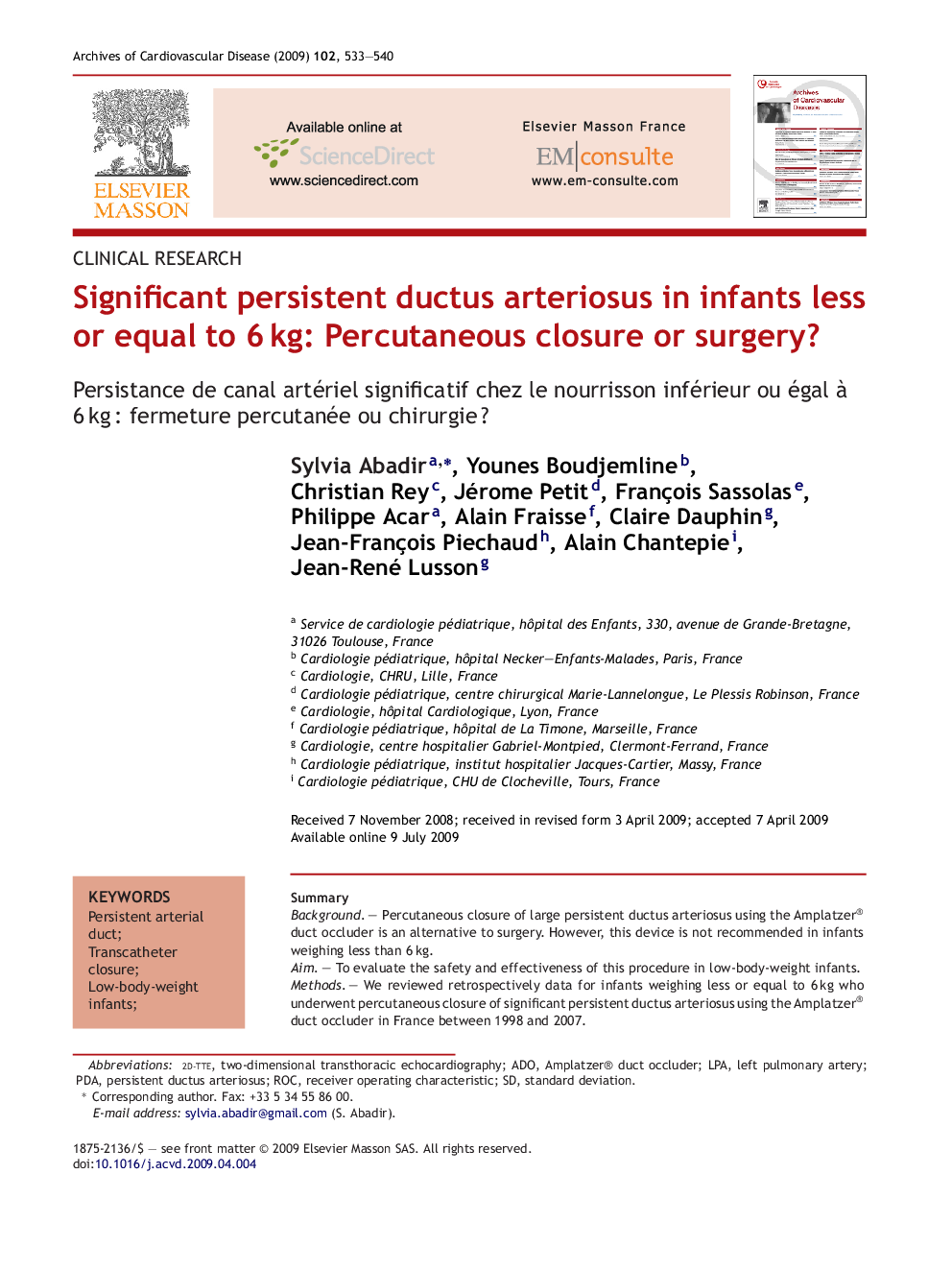| کد مقاله | کد نشریه | سال انتشار | مقاله انگلیسی | نسخه تمام متن |
|---|---|---|---|---|
| 2889532 | 1574402 | 2009 | 8 صفحه PDF | دانلود رایگان |

SummaryBackgroundPercutaneous closure of large persistent ductus arteriosus using the Amplatzer® duct occluder is an alternative to surgery. However, this device is not recommended in infants weighing less than 6 kg.AimTo evaluate the safety and effectiveness of this procedure in low-body-weight infants.MethodsWe reviewed retrospectively data for infants weighing less or equal to 6 kg who underwent percutaneous closure of significant persistent ductus arteriosus using the Amplatzer® duct occluder in France between 1998 and 2007.ResultsData for 58 patients (mean weight: 5 kg, range: 3.4–6; mean age: 5.5 months, range: 2.1–15.3) were reviewed. Mean angiographic persistent ductus arteriosus minimal diameter was 3.7 mm (range: 1–7.5). Implantation of the Amplatzer® duct occluder was successful in 89.7% of cases. In six (10.3%) patients, the device was not implanted because it would have led to significant aortic obstruction. One procedure-related death occurred in a 4 kg infant (1.7%). Major and minor complications occurred in 6.9 and 31.0% of patients, respectively. Persistent ductus arteriosus diameter greater than 3.7 mm, type C (tubular shape) and diameter/patient weight ratio greater than 0.91 were significantly associated with an unsuccessful procedure and/or major complications. During a median 10-month follow-up, no late device embolization occurred.ConclusionsAlthough percutaneous closure of significant persistent ductus arteriosus with the Amplatzer® duct occluder is effective in low-body-weight infants, the level and severity of complications indicate surgery as first-line treatment, at least until further studies are done to assess the safety and effectiveness of the new Amplatzer® duct occluder II in low-body-weight infants.
RésuméContexteLa fermeture percutanée de large canaux artériels persistants (CAP) avec la prothèse Amplatzer®Duct Occluder (ADO) est une alternative au traitement chirurgical. Cette prothèse est déconseillée chez les nourrissons de moins de 6 kg.ObjectifNotre objectif a été d’évaluer l’efficacité et la sécurité d’utilisation de cette prothèse dans cette population.MéthodesLes dossiers d’enfants de moins de 6 kg ayant subit une fermeture de CAP par la prothèse ADO en France entre 1998 et 2007 ont été analysés rétrospectivement.RésultatsCinquante-huit patients (poids moyen : 5 kg [3,4–6] ; âge moyen : 5,5 mois [2,1–15,3]) ont été inclus. Le diamètre minimal angiographique du CAP était de 3,7 mm (1–7,5). La prothèse a été implantée avec succès dans 89,7 % des cas. Chez six patients (10,3 %), la prothèse n’a pas été implantée en raison du risque de subocclusion aortique. Un nourrisson de 4 kg est décédé (1,7 %) secondairement à l’intervention. Le taux de complications majeures et mineures était de 6,9 et 31,0 %, respectivement. Un CAP de diamètre supérieur ou égal à 3,7 mm, de type C (forme tubulaire) et un ratio diamètre du CAP/poids de l’enfant supérieur à 0,91 étaient significativement associés à un échec d’intervention et/ou complication majeure. Aucune embolisation tardive n’est survenue après dix mois de suivi médian.ConclusionsLa fermeture de CAP significatifs avec la prothèse ADO chez les enfants de petit poids est efficace. Cependant, la fréquence et la sévérité des complications devraient conduire à choisir la ligature chirurgicale comme traitement de première intention, en attendant les résultats de la fermeture percutanée avec la nouvelle prothèse ADO II dans cette population.
Journal: Archives of Cardiovascular Diseases - Volume 102, Issues 6–7, June–July 2009, Pages 533–540